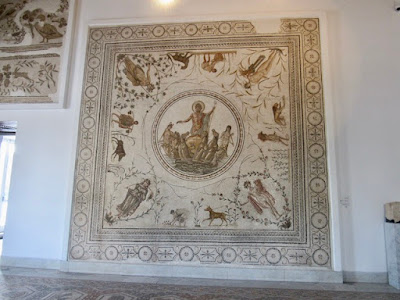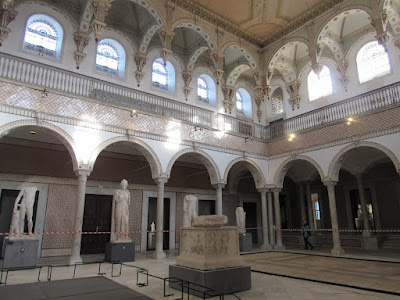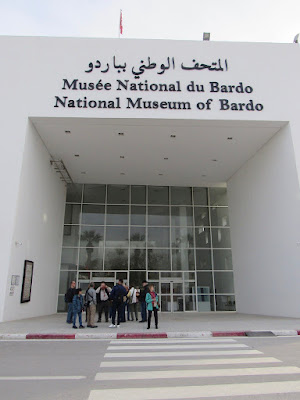
We went to the National Museum of Bardo, which has one of the world's finest collections of ancient Roman mosaics – including large-scale depictions of gods and heroes that once decorated the floors of luxurious villas built by its imperial rulers.
This museum, a former palace of an Ottoman governor and the current location of the Tunisian parliament, was ordered shut in July 2021, when President Kais Saied assumed wide-ranging powers and suspended parliament. After more than two years and extensive renovations, the Bardo reopened to the public on September 14.
Giant mosaics that were once the floors of Romans homes and buildings are now posted on the walls of the former palace. This mosaic features a stunning representation of Neptune, god the sea in the center, and a supporting cast of other gods and goddesses with a close-up of one woman.

Mosaics tell archeologists about the lives of the ancient culture. This culture used to have boxing contests.
We were able to walk on mosaic floors, which was the first time I've ever been able to do that.
This is another large room of the museum, which illustrates the majesty of the former palace.
Archeologists weren't always able to find all the pieces of a mosaic. However, they figured out how the mosaic fit together to get an idea of the entire image.
A beautiful collage of faces in mosaic.
North Africa used to have a vibrant Christian culture. Here is some evidence of the early Christians in Tunisia.

This mosaic is pictured in two parts. The Christian symbol (PX) identifies it as Christian. Constantine (325-370 CE) is displayed in the Constantine Room. He was the first Roman emperor to profess Christianity and allowed it to spread throughout the empire. Below is the floor in the Room with the cross symbol.
An early Christian baptismal font

This fancy harem had sculpted walls from top to bottom. They looked like lace. The building was a former palace and the harem room was preserved. Harems were typically the most elaborate places in the palace.

The Chimtou Coin Hoard

Sometimes the ancients left a "time capsule" for posterity. Such was the Chimtou Coin Hoard.
Before the construction of the Chimtou Museum, archeological test excavations were carried out on the site under the direction of Professor Dr. Mustapha Khanoussi. During this exploratory work one of the most significant gold coin hoards from the Roman period was discovered on May 12, 1993. At first a handful, then moments later hundreds of gold coins poured out of a shattered clay jar. In this container the Chimtou coin hoard, as it is now known, had been buried by its owner in the first third of the 5th century. It had been deposited on the southern fringes of the Roman city of Simitthus (today Chimtou), just to the east of a road leading south into the Majrada/Bagradas valley. The nearby ruins of residential buildings from the 2nd - 4th centuries may have served as a landmark for relocating the hiding place.
The coinage prerogative, above all the authority to mint, lay with the emperor. Official gold coin production was geographically decentralized, taking place in official coin-making workshops under the supervision of state coinage inspectors. The latter were accountable to the chief treasury official of the empire. Solidi were minted at the imperial mints of major cities or imperial seats. The name of the city was indicated by an abbreviation on the reverse of the solidus. From the 4th century Germanic rulers produced imitations of imperial gold and silver coins, so-called pseudo-imperial issues. Their provenance cannot be localized exactly, since they bear falsified sigla of imperial mints.
A stele (STEE-lee) or stela (STEE-lə) is a stone or wooden slab, generally taller than it is wide, erected as a monument. The surface of the stele often has text, ornamentation, or both that may be inscribed, carved in relief, or painted.
Stelae were created for many reasons. Grave stelae were used for funerary or commemorative purposes. Stelae as slabs of stone would also be used as ancient Greek and Roman government notices or as boundary markers of borders or property lines. Stelae were occasionally erected as memorials to battles. For example, along with other memorials, there are more than half-a-dozen steles erected on the battlefield of Waterloo at the locations of notable actions by participants in battle.
A traditional Western gravestone (headstone, tombstone, gravestone, or marker) may be considered the modern equivalent of ancient stelae, though the term is very rarely applied in this way. Stele-like forms in non-Western cultures are most consistently applied in archaeological contexts.
a mausoleum
Anas, our guide, is helping us to appreciate North Africa culture and history. His knowledge is extensive, and he strives to explain things with details, contexts, and examples. He also points out things we see and explain them. He's a marvelous teacher and guide.
Traffic and Cabs in Tunis
Like any big city traffic in Tunis is crazy. There are crosswalks, but cars go through them even when a pedestrian is trying to cross. In order to make crossing the street safely, our guide and bus driver would enter the street and hold up their hands to stop traffic to allow our group to cross the street.
Getting a taxi (the most common form of public transportation in Tunis) is yet another hair-raising experience, especially during rush hour. When we left the mosaic museum, we tried to get a taxi at the entrance, which was not on a main street. Taxis were readily available. We walked several blocks to the main drag and then couldn't get a taxi there either. Fortunately, a friend of Anas stopped and helped find a taxi for us. We needed four. One by one taxis stopped and took four people back to the hotel. I was one of the last people to get a ride. We were on our way and tried crossing a busy intersection. Unfortunately, a driver perpendicular to us was in a hurry and he crossed the intersection right in front of us. We hit. It wasn't too bad because traffic was slow, but the driver at fault had to fill out an accident form, send it to the police, and then pay a fine. This took a few minutes and at first our taxi driver told us to get out of the taxi and find another one. How we would do that was a mystery. There were several other people on our side of the street trying to flag a taxi as well. Suddenly, the drivers finished their business, and our driver told us to get back into the cab so he could take us to the hotel. Whew!
It had been less than a week since we started on our journey and I was uncharacteristically ready for some food I was used to eating, like a pizza. There was a pizza place near the hotel and I announced on our WhatsApp group that I was looking for anyone to join me. Jack from Oregon answered and we walked five minutes to the pizza place. It was a cheese pizza with a bit of pesto basil on it. Very good and very satisfying!
Tonight we had to pack our suitcases for an early start the next morning. Breakfast would be available at 4:30 with bags outside our room by 5:15 and departure at 5:30. We were supposed to go to the airport and catch a plane to Djerba Island, the mythical land of the Lotus Eaters in Homer's Odyssey. However, the plane cancelled. Fortunately, OAT always has a Plan B. We would take our bus six to eight hours south of Tunis to go to Djerba. That change of plans allowed us to see a long stretch of geography of 340 miles
Resources
Stele -- https://en.wikipedia.org/wiki/Stele
Texts by National Museum of Bardo























No comments:
Post a Comment